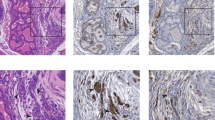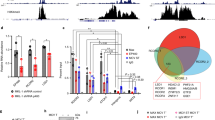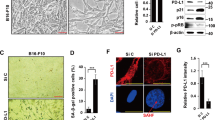Abstract
Whereas large T antigen (LT) of simian virus 40 (SV40) promotes oncogenesis by inactivating the tumor suppressor proteins p53 and pRb, SV40 small T antigen (ST) has been thought to be dispensable for this process. However, here we show that LT promotes both oncogenic growth and senescence in human cells expressing oncogenic Ras and that this latter effect is antagonized by ST. Inactivation of p53 by LT alone promoted the senescence-associated secretory phenotype (SASP), whereas the additional expression of ST attenuated this phenotype, allowing cells to avoid oncogene-induced senescence (OIS) and thereby promoting efficient oncogenesis. ST interacts with and inhibits the function of heterochromatin protein 1–binding protein 3 (HP1BP3), a positive regulator of global microRNA biogenesis, and it thereby triggers aberrant upregulation of B-cell translocation gene 2 (BTG2), which is essential for prevention of SASP and OIS by ST. Collectively, our results indicate that the HP1BP3-BTG2 axis constitutes a fail-safe system to prevent oncogenesis by means of OIS induction, and that this system is hijacked by ST.
This is a preview of subscription content, access via your institution
Access options
Subscribe to this journal
Receive 50 print issues and online access
$259.00 per year
only $5.18 per issue
Buy this article
- Purchase on Springer Link
- Instant access to full article PDF
Prices may be subject to local taxes which are calculated during checkout







Similar content being viewed by others
References
Serrano M, Lin AW, McCurrach ME, Beach D, Lowe SW. Oncogenic ras provokes premature cell senescence associated with accumulation of p53 and p16INK4a. Cell. 1997;88:593–602.
Ben-Porath I, Weinberg RA. The signals and pathways activating cellular senescence. Int J Biochem Cell Biol. 2005;37:961–76.
Kuilman T, Michaloglou C, Mooi WJ, Peeper DS. The essence of senescence. Genes Dev. 2010;24:2463–79.
Rodier F, Campisi J. Four faces of cellular senescence. J Cell Biol. 2011;192:547–56.
Coppe JP, Patil CK, Rodier F, Sun Y, Munoz DP, Goldstein J, et al. Senescence-associated secretory phenotypes reveal cell-nonautonomous functions of oncogenic RAS and the p53 tumor suppressor. PLoS Biol. 2008;6:2853–68.
Kuilman T, Michaloglou C, Vredeveld LC, Douma S, van Doorn R, Desmet CJ, et al. Oncogene-induced senescence relayed by an interleukin-dependent inflammatory network. Cell. 2008;133:1019–31.
Rodier F, Coppe JP, Patil CK, Hoeijmakers WA, Munoz DP, Raza SR, et al. Persistent DNA damage signalling triggers senescence-associated inflammatory cytokine secretion. Nat Cell Biol. 2009;11:973–9.
Yang G, Rosen DG, Zhang Z, Bast RC Jr., Mills GB, Colacino JA, et al. The chemokine growth-regulated oncogene 1 (Gro-1) links RAS signaling to the senescence of stromal fibroblasts and ovarian tumorigenesis. Proc Natl Acad Sci USA. 2006;103:16472–7.
Bartkova J, Rezaei N, Liontos M, Karakaidos P, Kletsas D, Issaeva N, et al. Oncogene-induced senescence is part of the tumorigenesis barrier imposed by DNA damage checkpoints. Nature. 2006;444:633–7.
Di Micco R, Fumagalli M, Cicalese A, Piccinin S, Gasparini P, Luise C, et al. Oncogene-induced senescence is a DNA damage response triggered by DNA hyper-replication. Nature. 2006;444:638–42.
Hahn WC, Counter CM, Lundberg AS, Beijersbergen RL, Brooks MW, Weinberg RA. Creation of human tumour cells with defined genetic elements. Nature. 1999;400:464–8.
Hahn WC, Dessain SK, Brooks MW, King JE, Elenbaas B, Sabatini DM, et al. Enumeration of the simian virus 40 early region elements necessary for human cell transformation. Mol Cell Biol. 2002;22:2111–23.
Rangarajan A, Hong SJ, Gifford A, Weinberg RA. Species- and cell type-specific requirements for cellular transformation. Cancer Cell. 2004;6:171–83.
Chen W, Possemato R, Campbell KT, Plattner CA, Pallas DC, Hahn WC. Identification of specific PP2A complexes involved in human cell transformation. Cancer Cell. 2004;5:127–36.
Uren A, Fallen S, Yuan H, Usubutun A, Kucukali T, Schlegel R, et al. Activation of the canonical Wnt pathway during genital keratinocyte transformation: a model for cervical cancer progression. Cancer Res. 2005;65:6199–206.
Yeh E, Cunningham M, Arnold H, Chasse D, Monteith T, Ivaldi G, et al. A signalling pathway controlling c-Myc degradation that impacts oncogenic transformation of human cells. Nat Cell Biol. 2004;6:308–18.
Akagi T, Sasai K, Hanafusa H. Refractory nature of normal human diploid fibroblasts with respect to oncogene-mediated transformation. Proc Natl Acad Sci USA. 2003;100:13567–72.
Moody CA, Laimins LA. Human papillomavirus oncoproteins: pathways to transformation. Nat Rev Cancer. 2010;10:550–60.
Chien Y, Scuoppo C, Wang X, Fang X, Balgley B, Bolden JE, et al. Control of the senescence-associated secretory phenotype by NF-κB promotes senescence and enhances chemosensitivity. Genes Dev. 2011;25:2125–36.
Nguyen HT, Hong X, Tan S, Chen Q, Chan L, Fivaz M, et al. Viral small T oncoproteins transform cells by alleviating hippo-pathway-mediated inhibition of the YAP proto-oncogene. Cell Rep. 2014;8:707–13.
de Boer E, Rodriguez P, Bonte E, Krijgsveld J, Katsantoni E, Heck A, et al. Efficient biotinylation and single-step purification of tagged transcription factors in mammalian cells and transgenic mice. Proc Natl Acad Sci USA. 2003;100:7480–5.
Matsumoto M, Matsuzaki F, Oshikawa K, Goshima N, Mori M, Kawamura Y, et al. A large-scale targeted proteomics assay resource based on an in vitro human proteome. Nat Methods. 2017;14:251–8.
Liu H, Liang C, Kollipara RK, Matsui M, Ke X, Jeong BC, et al. HP1BP3, a Chromatin retention factor for co-transcriptional microRNA processing. Mol Cell. 2016;63:420–32.
Boiko AD, Porteous S, Razorenova OV, Krivokrysenko VI, Williams BR, Gudkov AV. A systematic search for downstream mediators of tumor suppressor function of p53 reveals a major role of BTG2 in suppression of Ras-induced transformation. Genes Dev. 2006;20:236–52.
Mao B, Zhang Z, Wang G. BTG2: a rising star of tumor suppressors. Int J Oncol. 2015;46:459–64.
Choi OR, Ryu MS, Lim IK. Shifting p53-induced senescence to cell death by TIS21(/BTG2/Pc3) gene through posttranslational modification of p53 protein. Cell Signal. 2016;28:1172–85.
Lim IK, Choi JA, Kim EY, Kim BN, Jang S, Ryu MS, et al. TIS21(/BTG2) inhibits doxorubicin-induced stress fiber-vimentin networks via Nox4-ROS-ABI2-DRF-linked signal cascade. Cell Signal. 2017;30:179–90.
Wagener N, Bulkescher J, Macher-Goeppinger S, Karapanagiotou-Schenkel I, Hatiboglu G, Abdel-Rahim M, et al. Endogenous BTG2 expression stimulates migration of bladder cancer cells and correlates with poor clinical prognosis for bladder cancer patients. Br J Cancer. 2013;108:973–82.
Li WQ, Yu HY, Zhong NZ, Hou LJ, Li YM, He J, et al. miR27a suppresses the clonogenic growth and migration of human glioblastoma multiforme cells by targeting BTG2. Int J Oncol. 2015;46:1601–8.
Tong Z, Jiang B, Wu Y, Liu Y, Li Y, Gao M, et al. MiR-21 protected cardiomyocytes against doxorubicin-induced apoptosis by targeting BTG2. Int J Mol Sci. 2015;16:14511–25.
Tang Z, Li C, Kang B, Gao G, Li C, Zhang Z. GEPIA: a web server for cancer and normal gene expression profiling and interactive analyses. Nucleic Acids Res. 2017;45:W98–W102.
Qi F, Carbone M, Yang H, Gaudino G. Simian virus 40 transformation, malignant mesothelioma and brain tumors. Expert Rev Respir Med. 2011;5:683–97.
Strickler HD, Rosenberg PS, Devesa SS, Hertel J, Fraumeni JF Jr., Goedert JJ. Contamination of poliovirus vaccines with simian virus 40 (1955–63) and subsequent cancer rates. JAMA. 1998;279:292–5.
Olin P, Giesecke J. Potential exposure to SV40 in polio vaccines used in Sweden during 1957: no impact on cancer incidence rates 1960 to 1993. Dev Biol Stand. 1998;94:227–33.
Chen W, Hahn WC. SV40 early region oncoproteins and human cell transformation. Histol Histopathol. 2003;18:541–50.
Buganim Y, Solomon H, Rais Y, Kistner D, Nachmany I, Brait M, et al. p53 regulates the Ras circuit to inhibit the expression of a cancer-related gene signature by various molecular pathways. Cancer Res. 2010;70:2274–84.
Acknowledgements
We thank T. Akagi for the pCX4 system as well as hTERT, SV40 ER, and H-RasG12V expression vectors; A. Sakiyama and K. Tsunematsu for technical assistance; members of our laboratories for comments on the manuscript; and A. Ohta for help in preparation of the manuscript. This work was supported in part by KAKENHI grants from Japan Society for the Promotion of Science (JSPS) and the Ministry of Education, Culture, Sports, Science, and Technology of Japan to KIN (18H05215, 17H06301, and 25221303) and to MM (17K19606, 17H05534, and 17H06011) as well as by the Project for Cancer Research and Therapeutic Evolution (P-CREATE) of the Japan Agency for Medical Research and Development (AMED). MM is also supported by Core Research for Evolutionary Science and Technology (CREST, JPMJCR15G4) of the Japan Science and Technology Agency (JST).
Author information
Authors and Affiliations
Contributions
KO designed and performed experiments, analyzed data, and prepared and wrote the manuscript. MM prepared and wrote the manuscript. MK performed flow cytometric analysis. HS performed gene expression profiling interactive analysis. KIN supervised the study and wrote the manuscript.
Corresponding authors
Ethics declarations
Conflict of interest
The authors declare that they have no conflict of interest.
Additional information
Publisher’s note Springer Nature remains neutral with regard to jurisdictional claims in published maps and institutional affiliations.
Supplementary information
Rights and permissions
About this article
Cite this article
Oshikawa, K., Matsumoto, M., Kodama, M. et al. A fail-safe system to prevent oncogenesis by senescence is targeted by SV40 small T antigen. Oncogene 39, 2170–2186 (2020). https://doi.org/10.1038/s41388-019-1139-1
Received:
Revised:
Accepted:
Published:
Issue Date:
DOI: https://doi.org/10.1038/s41388-019-1139-1
This article is cited by
-
Molecular dissection on inhibition of Ras-induced cellular senescence by small t antigen of SV40
Cellular and Molecular Life Sciences (2022)



